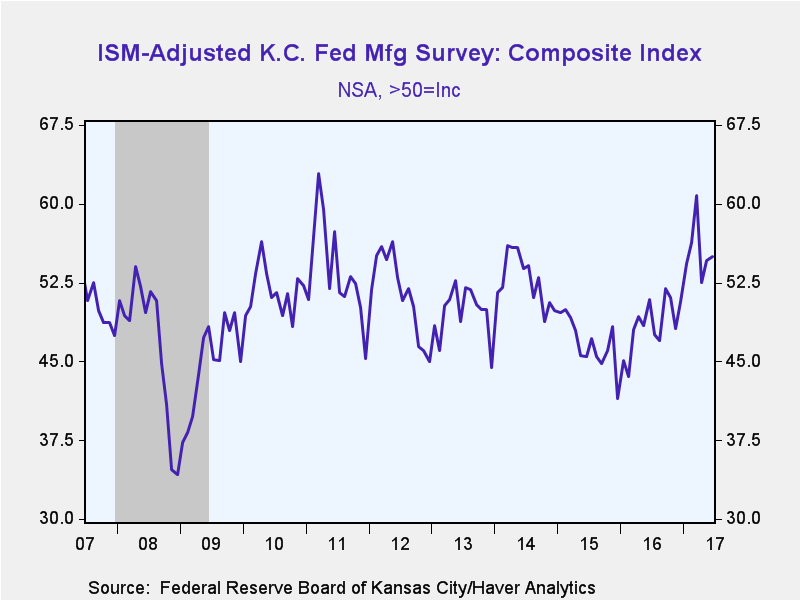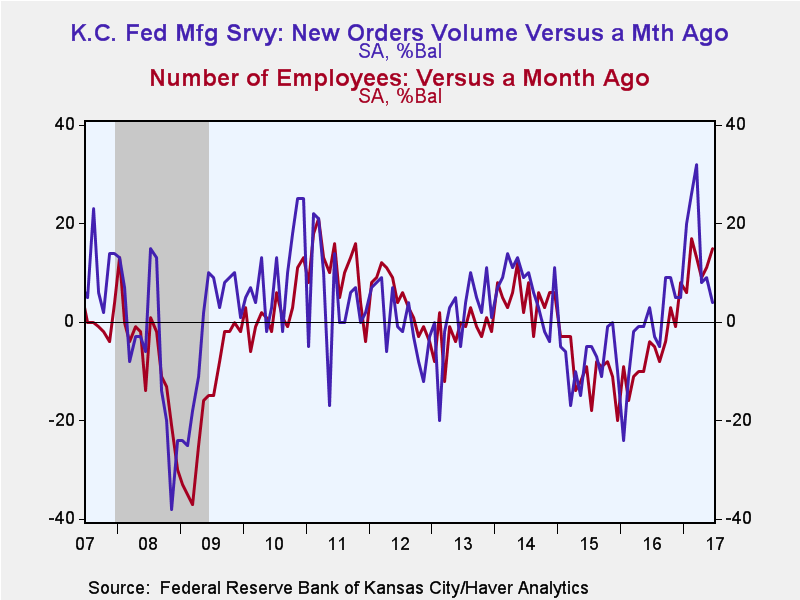 Global| Jun 22 2017
Global| Jun 22 2017Kansas City Federal Reserve Factory Index Improves
by:Tom Moeller
|in:Economy in Brief
Summary
The Federal Reserve Bank of Kansas City reported that its index of regional manufacturing sector business activity rose to 11 in June, following an unrevised improvement to eight in May. It remained down sharply from the March reading [...]
The Federal Reserve Bank of Kansas City reported that its index of regional manufacturing sector business activity rose to 11 in June, following an unrevised improvement to eight in May. It remained down sharply from the March reading of 20. The ISM-Adjusted index gained to 55.0 (NSA), but remained below the Q1 average of 57.1.
Movement amongst the index components was mixed. Production, employment, shipments and the workweek each moved higher. These gains were offset by lower readings for new orders, supplier delivery speeds, material inventories, order backlogs and export orders.
The index of finished goods prices declined following four months of increase. The raw materials prices index declined to the lowest level since November.
The overall expectations index eased following a strong May increase. Expected new orders, shipments, production and materials inventories each fell while employment gained.
Expectations for finished goods prices slipped to the lowest point since February but expected raw material prices increased following two months of sharp decline.
The diffusion indexes are calculated as the percentage of total respondents reporting increases minus the percentage reporting declines. The survey included 94 responses from plants in Colorado, Kansas, Nebraska, Oklahoma, Wyoming and northern New Mexico. Data for the Kansas City Fed Survey can be found in Haver's SURVEYS database.
| Kansas City Federal Reserve Manufacturing Survey (SA) | Jun | May | Apr | Jun '16 | 2016 | 2015 | 2014 |
|---|---|---|---|---|---|---|---|
| Conditions Versus One Month Ago (% Balance) | 11 | 8 | 7 | 2 | -2 | -6 | 6 |
| ISM-Adjusted Composite Index (NSA) | 55.0 | 54.6 | 52.5 | 50.9 | 48.5 | 46.8 | 52.7 |
| New Orders Volume | 4 | 9 | 8 | 3 | -1 | -8 | 7 |
| Number of Employees | 15 | 11 | 9 | -4 | -6 | -10 | 5 |
| Production | 23 | -1 | 12 | 14 | 1 | -5 | 7 |
| Prices Received for Finished Product | -2 | 8 | 5 | -4 | -7 | -5 | 5 |
| Expected Conditions in Six Months | 25 | 30 | 17 | 8 | 9 | 4 | 17 |
| New Orders Volume | 39 | 46 | 15 | 14 | 19 | 11 | 26 |
| Number of Employees | 32 | 24 | 26 | 12 | 8 | 6 | 18 |
| Production | 42 | 50 | 28 | 17 | 20 | 11 | 28 |
| Prices Received for Finished Product | 21 | 23 | 24 | 5 | 6 | 9 | 26 |
Tom Moeller
AuthorMore in Author Profile »Prior to joining Haver Analytics in 2000, Mr. Moeller worked as the Economist at Chancellor Capital Management from 1985 to 1999. There, he developed comprehensive economic forecasts and interpreted economic data for equity and fixed income portfolio managers. Also at Chancellor, Mr. Moeller worked as an equity analyst and was responsible for researching and rating companies in the economically sensitive automobile and housing industries for investment in Chancellor’s equity portfolio. Prior to joining Chancellor, Mr. Moeller was an Economist at Citibank from 1979 to 1984. He also analyzed pricing behavior in the metals industry for the Council on Wage and Price Stability in Washington, D.C. In 1999, Mr. Moeller received the award for most accurate forecast from the Forecasters' Club of New York. From 1990 to 1992 he was President of the New York Association for Business Economists. Mr. Moeller earned an M.B.A. in Finance from Fordham University, where he graduated in 1987. He holds a Bachelor of Arts in Economics from George Washington University.










